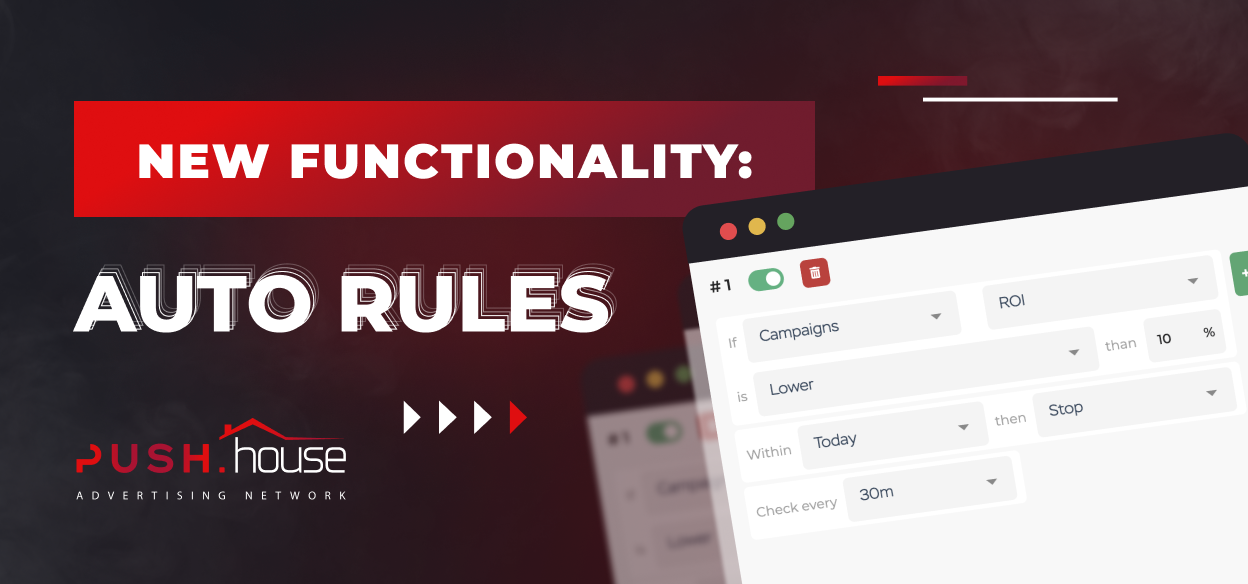
Automated Rules by Push.House
Hello! This is Push.House. Launching and optimizing ad campaigns is a labor-intensive process that requires complete control and immersion. Sometimes, even minor changes in statistics can lead to undesirable losses in the ad budget. To facilitate the process of control and subsequent analysis of ad campaigns, Push.House partners can use a special optimization tool based on predefined parameters – automated rules.
Automated Rules
Automated rules (auto-rules) are specific commands that enable the automatic evaluation of performance indicators and apply necessary changes based on pre-set configurations.
This tool not only saves time and frees you from detailed ad campaign control but also minimizes undesirable budget losses if the required statistical values are not achieved.
An automated rule is created during the ad campaign setup and can include up to 10 parameters influencing the final optimization changes. The system automatically analyzes your ad campaign data at set intervals and responds to any changes in the indicators corresponding to the predefined settings. For example, the bid may decrease if the campaign’s CR exceeds a specific value.
Capabilities and functionality of automated rules
Push.House functionality allows setting up automated rules to control:
Campaigns:


Suppose a selected metric becomes greater/lesser than a specified value within a set period. In that case, the system automatically decreases or increases the bid for the entire campaign or stops it.
Sources:


Suppose a selected metric becomes greater/lesser than a specified value within a set period. In that case, the system automatically decreases or increases the bid for a specific platform or adds it to white/blacklists.
Feeds:


Suppose a selected metric becomes greater/lesser than a specified value within a set period. In that case, the system automatically decreases or increases the bid for a specific feed or disables it.
Contact the Push.House manager to get started
Statistics indicators
Regarding the metrics themselves, currently, with automated rules, you can track the following indicators:
- Impressions – analyzing the number of impressions within a specified period.
- Clicks – analyzing the number of clicks within a specified period.
- Leads – analyzing the number of leads within a specified period.
- Spend – analyzing the amount spent on traffic within a specified period.
- Revenue – analysis of the amount received from promotion in a specific campaign, source or feed for a specified period.
- Cost per Lead – analyzing the average cost per lead within a specified period.
- CR – analyzing the conversion rate within a specified period.
- CTR – analyzing the click-through rate within a specified period.
- ROI – analyzing the return on investment within a specified period.
- Profit – analyzing the total profit within a specified period.
- Winrate – analyzing the volume of available traffic within a specified period.


The desired metric necessary for applying an automated rule is specified in a separate window. Depending on the evaluation metric the value can change. It can represent either whole numbers or percentages and specific sums.


Time Period
Each rule can be applied to a specific period – from 30 minutes to 7 days. Thus, the system evaluates the desired metric over a specific period and applies the automated rule if the advertiser’s set value is reached or not reached.


Changes made upon reaching or not reaching a certain value of the evaluated metric. They can be either an amount (bid change) or a command (campaign stoppage, source/feed disabling, or addition to black/white lists).


In cases where the goal of an automated rule is to change the bid, it’s necessary to specify the “rise of value” by which the change will occur and indicate the maximum value beyond which the bid cannot be raised.


Statistical updates occur automatically. The frequency is manually adjustable – from “every 30 minutes” to “once every 24 hours.”


You can add up to 10 parameters that influence the application of an automated rule. To add an additional parameter, click the green plus icon on the right. Then specify additional evaluation parameters in a new line.


It’s important to understand that when adding additional parameters, the system will apply the automated rule ONLY if the evaluated element (source, campaign, feed) meets all the conditions specified in the settings.
Example of Automated Rules Use
Let’s say the goal of our automated rule is to decrease the bid for a source if its CR falls below 12%, and the number of impressions exceeds 12,000.
To set this up, navigate to the campaign settings and select the evaluation element – Source.


Next, choose the evaluation element – CR. Set the desired values – less than 12%.


In this case, Impressions will be an additional evaluation parameter. To add them to the auto-rule settings, click the green plus icon. Then specify the required values – more than 12,000 in our case.


Set the evaluation period to 48 hours, and in the line below, choose “Decrease bid.”


Specify the “rise of value” change – $0.0001. And define the maximum value – $0.0004.


We recommend specifying the minimum value accepted in the region. This value can be found in the “Network Volume” section.


Then set the statistic update frequency to every 2 hours.


To add another rule click the corresponding icon at the bottom of the block.


Click “Start Campaign“ or “Save Changes” to activate the automated rule, depending on the setup stage.
Automated rules are beneficial for both experienced advertisers and those who are new to the Push.House ad network functionality, taking their first steps in CPA marketing. During initial launches, it’s often challenging to forecast upcoming changes without a clear strategy. Use automated rules to allocate your ad budget efficiently and achieve maximum profits from advertising with Push.House.
Best of luck!














